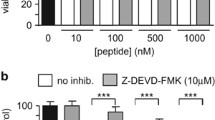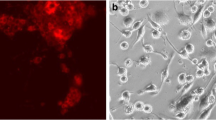Abstract
Whether reactive oxygen species (ROS) mediate β-amyloid (Aβ) neurotoxicity remains controversial. Naive PC12 cells (PC12) and nerve growth factor-differentiated PC12 cells (dPC12) were used to study the role of ROS in cell death induced by Aβ25–35. The viability of PC12 and dPC12 cells decreased by 30–40% after a 48-hour exposure to 20 µM Aβ25–35. Microscopic examination showed that Aβ25–35 induced necrosis in PC12 cells and apoptosis in dPC12 cells. Vitamin E (100 µM) and other antioxidants protected PC12 cells, but not dPC12 cells, against the cytotoxic effect of Aβ25–35. Since H2O2 has been proposed to be involved in Aβ toxicity, the effects of H2O2 on PC12 and dPC12 cells were studied. Differentiated PC12 cells appeared to be sgnificantly more resistant to H2O2 than naive PC12 cells. These data suggest that ROS may mediate Aβ25–35 toxicity in PC12 cells but not in dPC12 cells. Because the intracellular levels of ROS were elevated during the differentiation of PC12 cells, the baseline levels of ROS in these two model cell types may determine the intracellular mediators for Aβ25–35 toxicity. Therefore, the protective effects of antioxidants against Aβ may depend upon the redox state of the cells.
Similar content being viewed by others
References
Begley JG, Duan W, Chan S, Duff K, Mattson MP. Altered calcium homeostasis and mitochondrial dysfunction in cortical synaptic compartments of presenilin-1 mutant mice. J Neurochem 72:1030–1039;1999.
Behl C, Davis JB, Klier FG, Schubert D. Amyloid β peptide induces necrosis rather than apoptosis. Brain Res 645:253–264;1994.
Behl C, Davis JB, Lesley R, Schubert D. Hydrogen peroxide mediates amyloid β protein toxicity. Cell 77:817–827;1994.
Cafe C, Torri C, Bertorelli L, Angeretti N, Lucca E, Forloni G, Marzatico F. Oxidative stress after acute and chronic application of β-amyloid fragment 25–35 in cortical cultures. Neurosci Lett 203:61–65;1996.
Cotman CW, Anderson AJ. A potential role for apoptosis in neurodegeneration and Alzheimer's disease. Mol Neurobiol 10:19–45;1995.
Cotman CW, Su JH. Mechanisms of neuronal death in Alzheimer's disease. Brain Pathol 6:493–506;1996.
Ekinci FJ, Malik KU, Shea TB. Activation of the L voltage-sensitive calcium channel by mitogen-activated protein (MAP) kinase following exposure of neuronal cells to β-amyloid. MAP kinase mediates β-amyloid-induced neurodegeneration. J Biol Chem 274:30322–30327;1999.
Estus S, Tucker HM, van Rooyen C, Wright S, Brigham EF, Wogulis M, Rydel RE. Aggregated amyloid-β protein induces cortical neuronal apoptosis and concomitant ‘apoptotic’ pattern of gene induction. J Neurosci 17:7736–7745;1997.
Funakoshi H, Yonemasu T, Nakano T, Matumoto K, Nakamura T. Identification of Gas6, a putative ligand for Sky and Axl receptor tyrosine kinases, as a novel neurotrophic factor for hippocampal neurons. J Neurosci Res 68:150–160;2002.
Giovanni A, Keramaris E, Morris EJ, Hou ST, O'Hare M, Dyson N, Robertson GS, Slack RS, Park DS. E2F1 mediates death of β-amyloid-treated cortical neurons in a manner independent of p53 and dependent on Bax and caspase 3. J Biol Chem 275:11553–11560;2000.
Good PF, Werner P, Hsu A, Olanow CW, Perl DP. Evidence of neuronal oxidative damage in Alzheimer's disease. Am J Pathol 149:21–28;1996.
Isacson O, Seo H, Lin L, Albeck D, Granholm AC. Alzheimer's disease and Down's syndrome: Roles of APP, trophic factors and ACh. Trends Neurosci 25:79–84;2002.
Kim HY, Akbar M, Lau A, Edsall L. Inhibition of neuronal apoptosis by docosahexaenoic acid (22:6n-3). Role of phosphatidylserine in antiapoptotic effect. J Biol Chem 275:35215–35223;2000.
Li J, Lee JM, Johnson JA. Microarray analysis reveals an antioxidant responsive element-driven gene set involved in conferring protection from an oxidative stress-induced apoptosis in IMR-32 Cells. J Biol Chem 277:388–394;2001.
Li YP, Bushnell AF, Lee CM, Perlmutter LS, Wong SK. β-Amyloid induces apoptosis in human-derived neurotypic SH-SY5Y cells. Brain Res 738:196–204;1996.
Lockhart BP, Benicourt C, Junien JL, Privat A. Inhibitors of free radical formation fail to attenuate direct β-amyloid25–35 peptide-mediated neurotoxicity in rat hippocampal cultures. J Neurosci Res 39:494–505;1994.
Lucca E, Angeretti N, Forloni G. Influence of cell culture conditions on the protective effect of antioxidants against β-amyloid toxicity: Studies with lazaroids. Brain Res 764:293–298;1997.
MacManus A, Ramsden M, Murray M, Henderson Z, Pearson HA, Campbell VA. Enhancement of45Ca2+ influx and voltage-dependent Ca2+ channel activity by β-amyloid (1–40) in rat cortical synaptosomes and cultured cortical neurons. Modulation by the proinflammatory cytokine interleukin-1β. J Biol Chem 275:4713–4718;2000.
Magnani E, Bettini E. Resazurin detection of energy metabolism changes in serum-starved PC12 cells and of neuroprotective agent effect. Brain Res Brain Res Protoc 5:266–272;2000.
Markesbery WR. Oxidative stress hypothesis in Alzheimer's disease. Free Radic Biol Med 23:134–147;1997.
Mattson MP, Partin J, Begley JG. Amyloid β-peptide induces apoptosis-related events in synapses and dendrites. Brain Res 807:167–176;1998.
Murphy GM Jr, Yang L, Cordell B. Macrophage colony-stimulating factor augments β-amyloid-induced interleukin-1, interleukin-6, and nitric oxide production by microglial cells. J Biol Chem 273:20967–20971;1998.
Nitsch RM, Blusztajn JK, Pittas AG, Slack BE, Growdon JH, Wurtman RJ. Evidence for a membrane defect in Alzheimer disease brain. Proc Natl Acad Sci USA 89:1671–1675;1992.
Pappolla MA, Sos M, Omar RA, Bick RJ, Hickson-Bick DL, Reiter RJ, Efthimiopoulos S, Robakis NK. Melatonin prevents death of neuroblastoma cells exposed to the Alzheimer amyloid peptide. J Neurosci 17:1683–1690;1997.
Pereira C, Santos MS, Oliveira C. Involvement of oxidative stress on the impairment of energy metabolism induced by Aβ peptides on PC12 cells: Protection by antioxidants. Neurobiol Dis 6:209–219;1999.
Pike CJ, Ramezan-Arab N, Cotman CW, β-Amyloid neurotoxicity in vitro: Evidence of oxidative stress but not protection by antioxidants. J Neurochem 69:1601–1611;1997.
Praprotnik D, Smith MA, Richey PL, Vinters HV, Perry G. Plasma membrane fragility in dystrophic neurites in senile plaques of Alzheimer's disease: An index of oxidative stress. Acta Neuropathol (Berl) 91:1–5;1996.
Pratico D, Uryu K, Leight S, Trojanoswki JQ, Lee VM. Increased lipid peroxidation precedes amyloid plaque formation in an animal model of Alzheimer amyloidosis. J Neurosci 21:4183–4187;2001.
Raina AK, Takeda A, Nunomura A, Perry G, Smith MA. Genetic evidence for oxidative stress in Alzheimer's disease. Neuroreport 10:1355–1357;1999.
Rothe G, Valet G. Flow cytometric analysis of respiratory burst activity in phagocytes with hydroethidine and 2′,7′-dichlorofluorescin. J Leukoc Biol 47:440–448;1990.
Satoh T, Sakai N, Kubo T, Enokido Y, Uchiyama Y, Hatanaka H. Flow cytometric analysis of serum deprivation-induced apoptosis of PC12 cells, with special reference to role of bcl-2. Neurosci Lett 201:119–122;1995.
Selkoe DJ. Alzheimer's disease: Genes, proteins, and therapy. Physiol Rev 81:741–766;2001.
Simonian NA, Coyle JT. Oxidative stress in neurodegenerative diseases. Annu Rev Pharmacol Toxicol 36:83–106;1996.
Smith MA, Rottkamp CA, Nunomura A, Raina AK, Perry G. Oxidative stress in Alzheimer's disease. Biochim Biophys Acta 1502:139–144;2000.
Sohal RS, Dubey A. Mitochondrial oxidative damage, hydrogen peroxide release, and aging. Free Radic Biol Med 16:621–626;1994.
Subbarao KV, Richardson JS, Ang LC. Autopsy samples of Alzheimer's cortex show increased peroxidation in vitro. J Neurochem 55:342–345;1990.
Tan J, Town T, Placzek A, Kundtz A, Yu H, Mullan M. Bcl-XL inhibits apoptosis and necrosis produced by Alzheimer's beta-amyloid1–40 peptide in PC12 cells. Neurosci Lett 272:5–8;1999.
Troy CM, Rabacchi SA, Friedman WJ, Frappier TF, Brown K, Shelanski ML. Caspase-2 mediates neuronal cell death induced by β-amyloid. J Neurosci 20:1386–1392;2000.
Ueda K, Shinohara S, Yagami T, Asakura K, Kawasaki K. Amyloid β protein potentiates Ca2+ influx through L-type voltage-sensitive Ca2+ channels: A possible involvement of free radicals. J Neurochem 68:265–271;1997.
Varadarajan S, Yatin S, Aksenova M, Butterfield DA. Review: Alzheimer's amyloid β-peptide-associated free radical oxidative stress and neurotoxicity. J Struct Biol 130:184–208;2000.
Wang CN, Chi CW, Lin YL, Chen CF, Shiao YJ. The neuroprotective effects of phytoestrogens on amyloid β protein-induced toxicity are mediated by abrogating the activation of caspase cascade in rat cortical neurons. J Biol Chem 276:5287–5295;2001.
White AR, Zheng H, Galatis D, Maher F, Hesse L, Multhaup G, Beyreuther K, Masters CL, Cappai R. Survival of cultured neurons from amyloid precursor protein knock-out mice against Alzheimer's amyloid-β toxicity and oxidative stress. J Neurosci 18:6207–6217;1998.
Zhang Z, Rydel RE, Drzewiecki GJ, Fuson K, Wright S, Wogulis M, Audia JE, May PC, Hyslop PA. Amyloid β-mediated oxidative and metabolic stress in rat cortical neurons: No direct evidence for a role for H2O2 generation. J Neurochem 67:1595–1606;1996.
Zhou Y, Gopalakrishnan V, Richardson JS. Actions of neurotoxic β-amyloid on calcium homeostasis and viability of PC12 cells are blocked by antioxidants but not by calcium channel antagonists. J Neurochem 67:1419–1425;1996.
Author information
Authors and Affiliations
Rights and permissions
About this article
Cite this article
Sung, YJ., Cheng, Cl., Chen, CS. et al. Distinct mechanisms account for β-amyloid toxicity in PC12 and differentiated PC12 neuronal cells. J Biomed Sci 10, 379–388 (2003). https://doi.org/10.1007/BF02256429
Received:
Accepted:
Issue Date:
DOI: https://doi.org/10.1007/BF02256429




